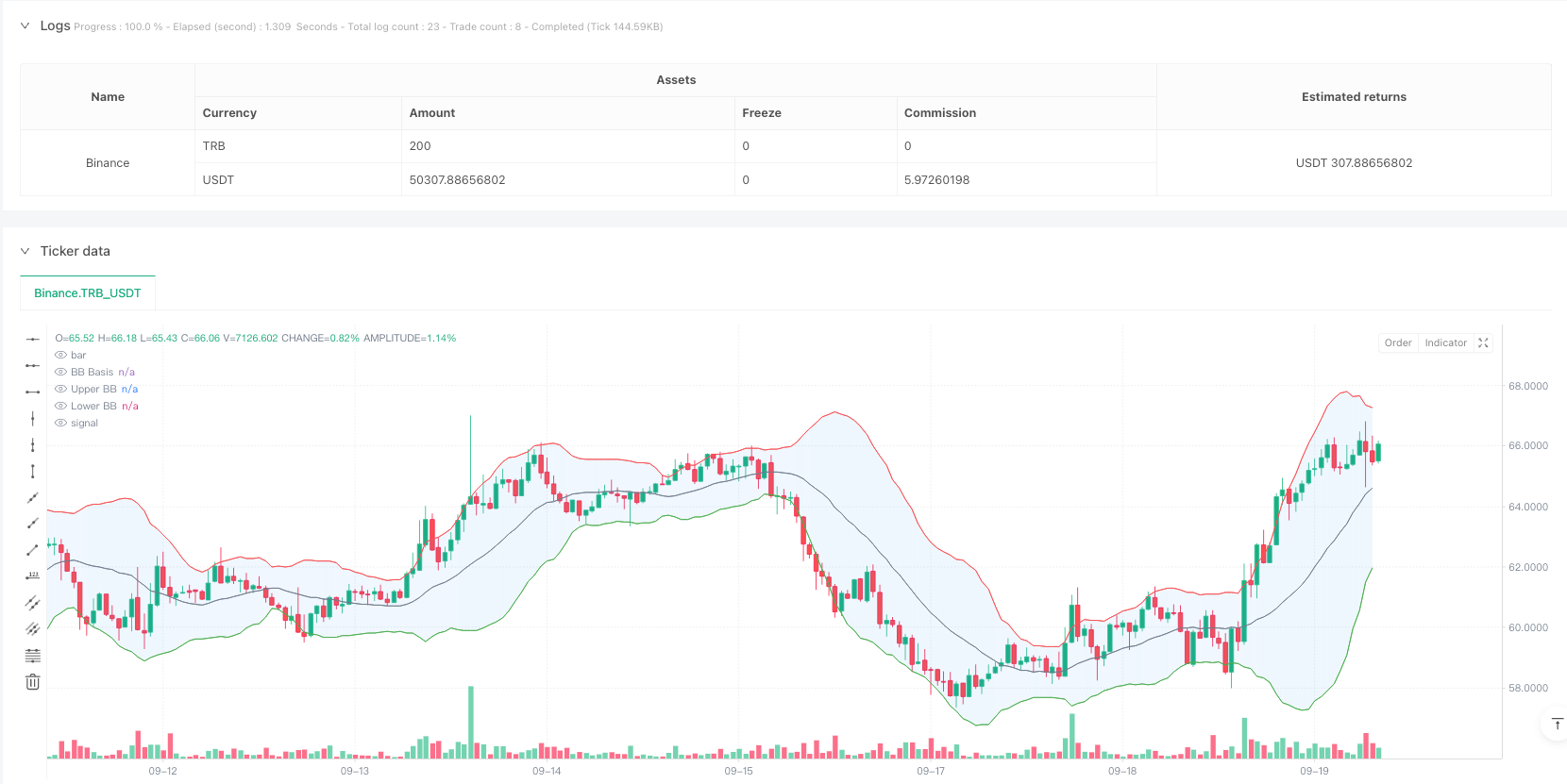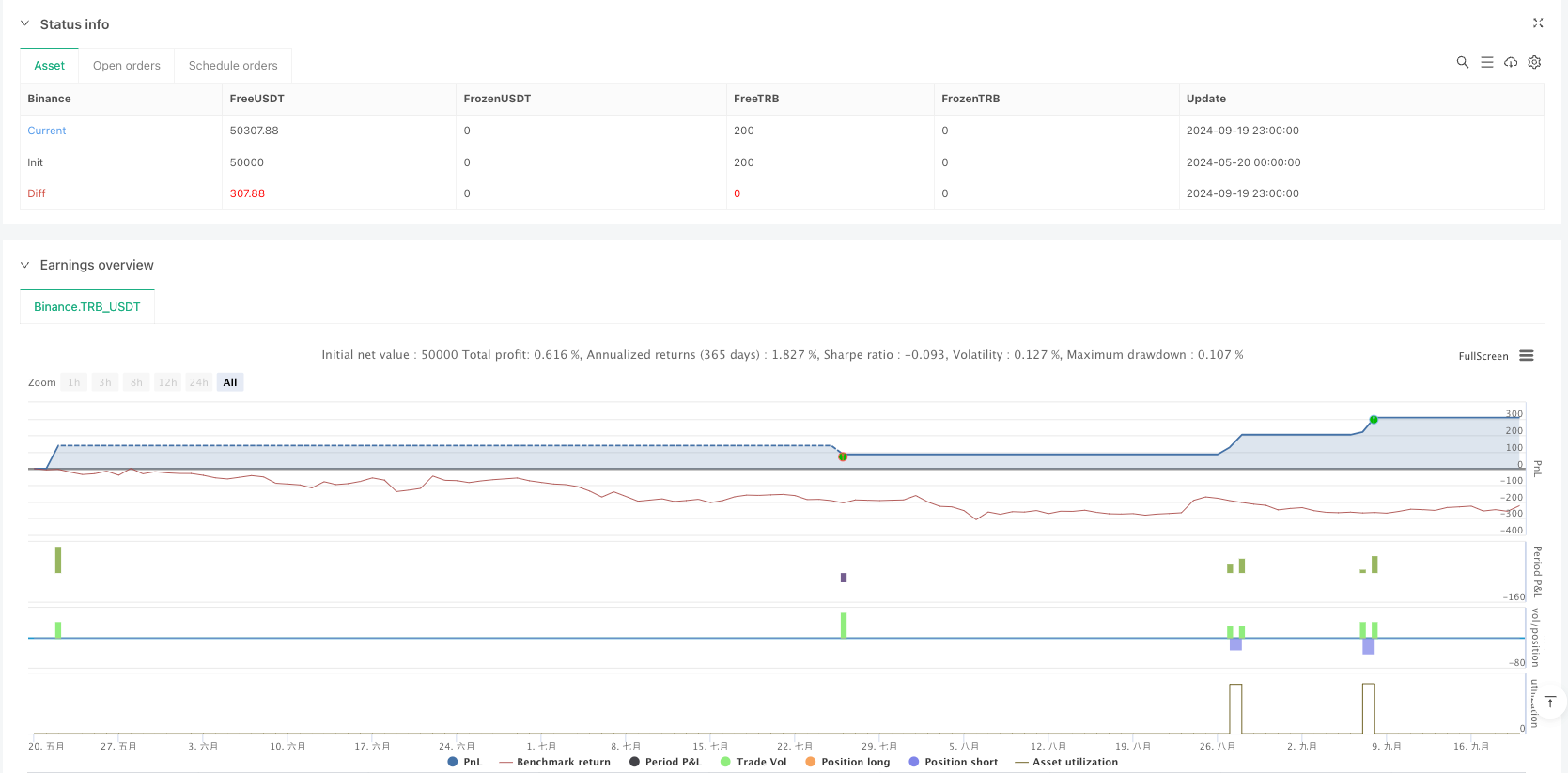

概述
这是一个结合了布林带(Bollinger Bands)、移动平均线离散度(MACD)和成交量分析的高频交易策略系统。该策略通过识别价格在布林带上下轨的突破和回归,结合MACD动量指标和成交量确认,来捕捉市场的反转机会。系统设置了每日最大交易次数限制,并配备了完善的风险管理机制。
策略原理
策略主要基于以下三个核心指标组合: 1. 布林带指标:使用20周期的简单移动平均线(SMA)作为中轨,标准差乘数为2.0计算上下轨。当价格突破布林带后回归时,系统会发出潜在的交易信号。 2. MACD指标:采用标准参数设置(12,26,9),用于确认价格趋势动量。当MACD线位于信号线上方时确认做多信号,位于信号线下方时确认做空信号。 3. 成交量分析:使用20周期移动平均确认成交量,要求信号出现时的成交量至少达到平均水平,以确保市场参与度。
策略优势
- 多重信号确认:通过布林带、MACD和成交量三重验证,显著提高了交易信号的可靠性。
- 可视化设计:系统提供丰富的图表指示,包括布林带填充、信号标记和背景颜色变化,便于交易者快速识别交易机会。
- 风险控制完善:实施了固定止损和获利目标,并限制每日最大交易次数,有效控制风险敞口。
- 系统化操作:策略提供了清晰的入场和出场条件,减少了主观判断带来的不确定性。
策略风险
- 市场波动风险:在高波动市场中,可能出现虚假突破信号,导致交易损失。
- 滑点风险:高频交易环境下,可能面临较大的滑点成本,影响实际收益。
- 流动性风险:成交量条件可能在市场流动性不足时限制交易机会。
- 系统性风险:固定的参数设置可能无法适应市场条件的剧烈变化。
策略优化方向
- 参数动态优化:可引入自适应参数调整机制,使布林带和MACD参数能够根据市场条件自动调整。
- 市场周期识别:增加市场周期判断模块,在不同市场周期下采用不同的交易策略。
- 风险管理优化:可考虑引入动态止损机制,根据市场波动性调整止损位置。
- 信号过滤增强:增加趋势强度过滤器,避免在横盘市场产生过多交易信号。
总结
该策略通过布林带反转信号、MACD趋势确认和成交量验证的组合,构建了一个完整的交易系统。系统的可视化设计和严格的风险控制使其特别适合日内交易。虽然存在一定的市场风险,但通过持续优化和参数调整,策略有望在不同市场环境下保持稳定表现。
策略源码
/*backtest
start: 2024-05-20 00:00:00
end: 2024-09-20 00:00:00
period: 1h
basePeriod: 1h
exchanges: [{"eid":"Binance","currency":"TRB_USDT"}]
*/
//@version=5
// Bollinger Bounce Reversal Strategy - Visual Edition
//
// Description:
// This strategy seeks to capture reversal moves at extreme price levels (“bounce points”) using Bollinger Bands.
// A long entry is triggered when the price, after being below the lower Bollinger Band, crosses upward above it,
// provided that the MACD line is above its signal line (indicating bullish momentum) and volume is strong.
// Conversely, a short entry is triggered when the price, after being above the upper Bollinger Band, crosses downward
// below it, with the MACD line below its signal line and high volume.
// To help avoid overtrading, the strategy limits entries to a maximum of 5 trades per day.
// Risk management is applied via fixed stop‑loss and take‑profit orders.
// This version overlays many visual cues on the chart: filled Bollinger Bands, signal markers, background colors,
// and an on‑chart information table displaying key values.
//
// Backtesting Parameters:
// • Initial Capital: $10,000
// • Commission: 0.1% per trade
// • Slippage: 1 tick per bar
//
// Disclaimer:
// Past performance is not indicative of future results. This strategy is experimental and provided solely for educational
// purposes. Please backtest and paper trade under your own conditions before live deployment.
//
// Author: [Your Name]
// Date: [Date]
strategy("Bollinger Bounce Reversal Strategy - Visual Edition", overlay=true, initial_capital=10000,
default_qty_type=strategy.percent_of_equity, default_qty_value=5,
commission_type=strategy.commission.percent, commission_value=0.1, slippage=1)
// ─── INPUTS ─────────────────────────────────────────────────────────────
bbPeriod = input.int(20, "Bollinger Bands Period", minval=1)
bbStd = input.float(2.0, "BB StdDev Multiplier", step=0.1)
macdFast = input.int(12, "MACD Fast Length", minval=1)
macdSlow = input.int(26, "MACD Slow Length", minval=1)
macdSignal = input.int(9, "MACD Signal Length", minval=1)
volAvgPeriod = input.int(20, "Volume MA Period", minval=1)
volFactor = input.float(1.0, "Volume Spike Factor", step=0.1) // Volume must be >= volAvg * factor
stopLossPerc = input.float(2.0, "Stop Loss (%)", step=0.1) * 0.01
takeProfitPerc = input.float(4.0, "Take Profit (%)", step=0.1) * 0.01
// ─── CALCULATIONS ─────────────────────────────────────────────────────────
basis = ta.sma(close, bbPeriod)
dev = bbStd * ta.stdev(close, bbPeriod)
upperBB = basis + dev
lowerBB = basis - dev
[macdLine, signalLine, _] = ta.macd(close, macdFast, macdSlow, macdSignal)
volAvg = ta.sma(volume, volAvgPeriod)
// ─── VISUALS: Bollinger Bands & Fill ───────────────────────────────────────
pBasis = plot(basis, color=color.gray, title="BB Basis")
pUpper = plot(upperBB, color=color.red, title="Upper BB")
pLower = plot(lowerBB, color=color.green, title="Lower BB")
fill(pUpper, pLower, color=color.new(color.blue, 90), title="BB Fill")
// ─── DAILY TRADE LIMIT ─────────────────────────────────────────────────────
// Reset the daily trade count at the start of each new day; limit entries to 5 per day.
var int tradesToday = 0
if ta.change(time("D"))
tradesToday := 0
// ─── SIGNAL LOGIC ─────────────────────────────────────────────────────────
// Define a "bounce" signal:
// For a long signal, require that the previous bar was below the lower band and the current bar crosses above it,
// the MACD line is above its signal, and volume is high.
longSignal = (close[1] < lowerBB and close > lowerBB) and (macdLine > signalLine) and (volume >= volFactor * volAvg)
// For a short signal, require that the previous bar was above the upper band and the current bar crosses below it,
// the MACD line is below its signal, and volume is high.
shortSignal = (close[1] > upperBB and close < upperBB) and (macdLine < signalLine) and (volume >= volFactor * volAvg)
// Plot visual signal markers on the chart.
plotshape(longSignal, title="Long Signal", style=shape.labelup, location=location.belowbar, color=color.green, text="Long", size=size.small)
plotshape(shortSignal, title="Short Signal", style=shape.labeldown, location=location.abovebar, color=color.red, text="Short", size=size.small)
// Change background color on signal bars for an extra cue.
bgcolor(longSignal ? color.new(color.green, 80) : shortSignal ? color.new(color.red, 80) : na, title="Signal BG")
// Only enter trades if fewer than 5 have been taken today.
if longSignal and (tradesToday < 5)
strategy.entry("Long", strategy.long)
tradesToday += 1
if shortSignal and (tradesToday < 5)
strategy.entry("Short", strategy.short)
tradesToday += 1
// ─── RISK MANAGEMENT: STOP-LOSS & TAKE-PROFIT ─────────────────────────────
// For long positions: set stop loss and take profit relative to the entry price.
if strategy.position_size > 0
strategy.exit("Long Exit", "Long", stop=strategy.position_avg_price*(1 - stopLossPerc), limit=strategy.position_avg_price*(1 + takeProfitPerc))
// For short positions: set stop loss and take profit relative to the entry price.
if strategy.position_size < 0
strategy.exit("Short Exit", "Short", stop=strategy.position_avg_price*(1 + stopLossPerc), limit=strategy.position_avg_price*(1 - takeProfitPerc))
相关推荐